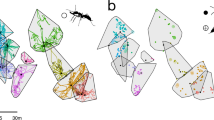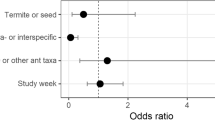Abstract
Foraging strategy of ant workers has been studied from several aspects, however, the mode of prey retrieval and factors affecting it have been rarely studied to date, even thought it is an important aspect for understanding ant foraging strategy. We investigated the behavioral response against large prey for 44 ant species of 34 genera belonging to eight subfamilies in Japan, Malaysia and Indonesia. Workers of most arboreal ants cut-up large prey at the site of prey capture, and individual workers retrieve the smaller pieces to the nests. In contrast, in most ground-living species, a group of workers retrieve large prey cooperatively without fragmentation. On the ground, parts of the prey item were often robbed by other ant species during this process, while such interference was rare on trees. The significance of the relation between nest site and mode of prey retrieval is discussed.


Similar content being viewed by others
References
Brown WL (1960) Contribution towards a reclassification of the Formicidae. III Tribe Amblyoponini (Hymenoptera). Bull Mus Comp Zool Harv Univ 122:145–230
Blüthgen N, Gebauer G, Fiedler K (2003) Disentagling a reinforest food web using stable isotopes: dietary diversity in a species-rich ant community. Oecologia 137:426–435
Brühl CA, Gunsalam G, Linsenmair KE (1998) Stratification of ants (Hymenoptera, Formicidae) in a primary rain forest in Sabah, Borneo. J Trop Ecol 14:285–297
Carroll CR, Janzen DH (1973) Ecology of foraging by ants. Annu Rev Ecol Syst 4:231–257
Davidson DW (1998) Resource discovery versus resource domination in ants: breaking the trade-off. Ecol Entomol 23:484–490
Davidson DW, Cook SC, Snelling RR, Chua TH (2003) Explaining the abundance of ants in lowland tropical rainforest canopies. Science 300:969–972
Davidson DW, Cook SC, Snelling RR (2004) Liquid-feeding performances of ants (Formicidae): ecological and evolutionary implications. Oecologia 139:255–266
Dejean A, Solano PJ, Ayroles J, Corbara B, Orivel J (2005) Arboreal ants build traps to capture prey. Nature 434:973
Detrain C, Deneubourg JL, Pasteels JM (1999) Information processing in social insects. Birkhauese-Verlag, Basel
Dijeto-Lordon C, Richard FJ, Owona C, Gibernau M, Orivel J, Dejean A (2001a) The predatory behavior of the dominant arboreal ant species Tetramorium aculeatum (Hymenoptera: Formicidae). Sociobiology 38:765–775
Dijeto-Lordon C, Orivel J, Dejean A (2001b) Consuming large prey on the spot by the African ponerine ant Platythyrea modesta (Hymenoptera: Formicidae). Insectes Soc 48:324–326
Federle W, Rohrseitz KEL, Hölldobler B (2000) Attachment forces of ants measured with a centrifuge: better ‘was-runner’ have a poorer attachment to a smooth surface. J Exp Biol 203:505–512
Federle W, Brainerd EL, McMahon TA, Hölldobler B (2001) Biomechanics of the movable pretarsal adhesive organ in ants and bees. PNAS 98:6215–6220
Floren A, Biun A, Linsenmair KE (2002) Arboreal ants as key predators in tropical lowland rainforest trees. Oecologia 131:137–144
Franks NR, Sendova-Franks AB, Anderson C (2001) Division of labour within teams of New World and Old World army ants. Anim. Behav. 62:635–642
Freeland J, Crozier RH, Marc J (1982) On the occurrence of arolia in ant feet. J Aust Entomol Soc 21:257–262
Gobin B, Peeters C, Billen J (1998) Colony reproduction and arboreal life in the ponerine ant Gnamptgenys menadensis. Neth J Zool 48:53–63
Gotwald WH Jr (1995) Army ants: the biology of social predation. Cornell University Press, Ithaca, NY.
Hashimoto Y, Yamane SK, Itioka T (1997) A preliminary study on dietary habits of ants in a Bornean rain forest. Jpn J Entomol 65:688–695
Hirosawa H, Higashi S, Mohamed M (2000) Food habits of Aenictus army ants and their effects on the ant community in a rain forest of Borneo. Insectes Soc 47:42–49
Hölldobler B, Wilson EO (1990) The ants. Belknap, Cambridge, MA
Ito F, Yamane SK, Eguchi K, Noerdjito WA, Kahono S, Tsuji K, Ohkawara K, Yamauchi K, Nishida T, Nakamura K (2001) Ant species diversity in the Bogor Botanic Garden, West Java, Indonesia, with description of two new species of the genus Leptanilla (Hymenoptera, Formicidae). Tropics 10:379–404
Japanese ant database group (2003) Ants of Japan. Gakken, Tokyo
Maschwitz U, Hänel H (1985) The migrating herdsman Dolichoderus (Diabolus) cuspidatus: an ant with a novel mode of life. Behav Ecol Sociobiol 17:171–184
Masuko K (1990) Behavior and ecology of the enigmatic ant Leptanilla japonica Baroni Urbani (Hymenoptera: Formicidae: Leptanillinae). Insectes Soc 37:31–57
Masuko K (1993) Predation of centipedes by the primitive ant Amblyopone silvestrii. Bull Assoc Nat Sci Senshu Univ 24:35–44
Ngnegueu PR, Dejean A (1994) Feeding behavior and worker polymorphism in the carpenter ant Atopomyrmex mocquerysi Andre. In: Lenoir A, Arnold G, Lepage M (eds) Les Insectes Sociaux. Universite Paris Nord, Paris, p 481
Richard FJ, Fabre A, Dejean A (2001) Predatory behavior in dominant arboreal ant species: the case of Crematogaster sp. (Hymenoptera: Formicidae). J Insect Behav 14:271–282
Sakamoto N, Yamane SK (1997) Food habits of a Japanese carpenter ant, Camponotus (Myrmamblys) nawai Ito (Hymenoptera: Formicidae). Jpn J Entomol 65:37–46
Savolainen R, Vepsalainen K (1988) A competition hierarchy among boreal ants: impact on resource partitioning and community structure. Oikos 51:135–155
Taylor RW (1978) Nothomyrmecia macrops: a living-fossil ant rediscovered. Science 201:979–985
Tobin JE (1994) Ants as primary consumers: diet and abundance in the Formicidae. In: Hunt PS, Nelpa CA (eds) Nourishment and evolution in insect societies. Westview, Boulder, pp 279–307
Tobin JE (1995) Ecology and diversity of tropical forest canopy ants. In: Lowman MD, Nadkarni NM (eds) Forest canopies. Academic, London, pp 129–147
Traniello JFA (1989) Foraging strategies of ants. Annu Rev Entomol 34:191–210
Widodo SE, Mohamed M, Hashimoto Y (2001) Canopy ant diversity assessment in the fragmented rainforest of Sabah, East Malaysia. Nature and Human activity 6:13–23
Wojtusiak J, Godzinska EJ, Dejean A (1995) Capture and retrieval of very large prey by workers of the African weaver ant, Oecophylla longinoda (Latreille 1802). Trop Zool 8:309–318
Acknowledgements
We thank Eva Kaufmann and Johan Billen for comments that greatly improved this manuscript, two anonymous reviewers for constructive criticisms, Bruno Gobin for comments on an earlier draft, Hirofumi Sumitomo and Takayoshi Doi for their help during field observation in Japan, and Rosli Hashim for his kind help and arrangement of accommodation in Malaysia. Research in Indonesia was permitted by LIPI. This work was partly supported by the grants in aid for scientific research from JSPS [Nos.116911308(A) and 14405036(B)].
Author information
Authors and Affiliations
Corresponding author
Rights and permissions
About this article
Cite this article
Yamamoto, A., Ishihara, S. & Ito, F. Fragmentation or Transportation: Mode of Large-Prey Retrieval in Arboreal and Ground Nesting Ants. J Insect Behav 22, 1–11 (2009). https://doi.org/10.1007/s10905-008-9126-3
Revised:
Accepted:
Published:
Issue Date:
DOI: https://doi.org/10.1007/s10905-008-9126-3




